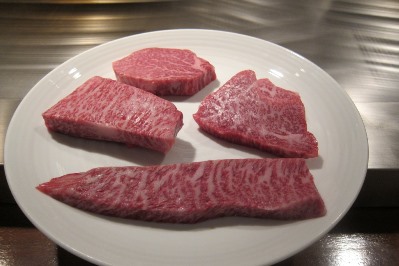The New Truth About Kobe Beef: Scarce Amounts Now Available In The U.S., But Not In Europe

Singapore (7 January 2014) - It’s been almost two years since I wrote Food’s Biggest Scam: The Great Kobe Beef Lie, here in the pages of Forbes.com. That story assumed a life of its own, becoming one of the most widely read food stories of the year and garnering well over a million views. It continues to be heavily viewed to this day, and since it was the most read of the hundreds of online pieces I have written, I safely assume it is a topic that interests a lot of people. But the playing field has changed significantly since 2012, so I am revisiting the topic with the new truth about the world’s most famous and coveted beef.
The single most important element of my original piece was the fact (as in fact, not opinion) that no beef from Japan, not one ounce in any form, was allowed to be imported into this country by the USDA, starting back in 2009. To that end, every single restaurant in the nation that claimed Kobe beef on its menu, and there were hundreds, was lying (along with retailers). Many were charging very top dollar, three figures for steaks or $50 for a burger, and implicated in this scam were numerous celebrity chefs. Not surprisingly, I received comments from many folks who had paid such handsome amounts for what I termed “faux-be” beef, and they were understandably outraged because they had been ripped off, pure and simple. To be fair, I also received plenty of comments from folks who took a “so what?” attitude and I imagine they will feel pretty much the same way about the news that Kobe beef has returned to the US.
 |
Real Kobe beef, four different cuts, at the Kobe Plaisir restaurant in Kobe, Japan. Note how evenly distributed the fat is throughout the entire steaks, the signature of this beef. |
A second and more complicated issue is the menu gray areas of “Japanese beef,” “Japanese Wagyu,” “Domestic Wagyu,” or Wagyu in general. The first two terms clearly suggest that the product comes from Japan, just as I would completely expect Colombian Coffee or French Champagne to come from Colombia and France, no ifs, ands or buts. Again, this was a big lie given the total ban on the importation of Japanese beef. As for Wagyu, while the word can literally be interpreted as any cattle in Japan, it has widely come to be used to mean several specific historically Japanese breeds (including Tajima-gyu, the only one that can legally be labelled Kobe beef). In several cases purebred Wagyu were exported from Japan, especially to Australia and the US, where some – but certainly not all – farmers have continued to breed them with pure bloodlines. In this country, much of the Japanese cattle has been cross bred with domestic stock and diluted, often heavily, to intentionally produce a result more in keeping with the traditional texture and taste of American beef (and to reduce costs). While there are absolutely some very conscientious and high quality farmers raising pure Japanese breed cattle in the US who produce excellent beef, this niche is largely unregulated and free from governmental labeling requirements that would give the consumer any protection or useful information.
 |
Some of the elaborate paperwork that accompanies Japanese beef. The certificate includes detailed info on the steer and its lineage, the smaller cards to the left go to restaurants and retailers as the beef is cut up and for real Kobe beef, the flower logo stickers at top are added to the certificate. |
For more information, visit Forbes website here.

The information below is required for social login
Sign In
Create New Account